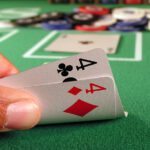Beginners generally have trouble knowing how much to bet when they hit a hand. For the most part they know to “take away the other guy’s pot odds,” but there’s more to betting than that. Because… tell me if this happens to you… You have AK in early position. You raise it preflop and get callers. You flop top pair and there is a draw on the board. So you bet the pot, PLUS on the flop and turn with someone calling you. On the river the draw MISSES and you make a smaller bet. The other guy raises the crap out of you (or even pushes). You figure him for a busted draw, call him, and get destacked by the set he flopped when his pocket pair hit. You think ‘WHAT DO I HAVE TO DO TO WIN A HAND AROUND HERE!!!’ Then you either reload or change tables because you’re embarrassed.
I’m going to teach you a rule for betting NL ring (low buy-in, although it’s pretty universally true).
WITH TPTK OR AN OVERPAIR (EVEN ACES), BET HALF TO 2/3 THE POT throughout the hand. IF YOU ARE RAISED (EVEN MIN. RAISED) YOU ARE BEAT. Lay it down unless you have a strong redraw of some sort. As long as you are just being called then you are going to win the hand 90% of the time. When you get raised, you are beat 90% of the time. Nothing in poker is 100%. Someone can bluff you with this rule. And sometimes really passive players will never raise if you’re betting into them.
The alternative to this (in late position) is if someone is betting less than 60% of the pot into you then you are probably ahead (but now it’s closer to 65% instead of 90%). There are ways to put the guy to the test, but this isn’t about that. But if someone is betting 30% of the pot into you and you have TPTK, then you are ahead 90% of the time. Min raise them to get the bet over 50% of the pot. If they reraise, push! IT’S THE 10% !!! If they call they are probably on the draw and will check on the next card. IF they bet into you again, be wary. Just call them down as long as their bets are LESS THAN 50% of the pot.
This is a rule of thumb that you will find almost PSYCHIC in its ability to keep you out of trouble and allow you to play TPTK or 2 pair with confidence. 2 pair plays exactly the same way!! And if you think someone hit their draw but aren’t sure, just use this rule. Assume they didn’t and play the hand until they raise or bet more than 50% of the pot into you. (But remember that 50% of the pot INTO you is a 65% chance you’re good, but a 30% bet into you is a 90% chance you’re good). I hate math, but that’s the way it goes.
Here’s a psychological move you can try if you want to get froggy. You limp into a pot from early position or the blinds. The flop comes all the same suit. If you want to take a chance and bluff some people out of their shoes, then take about half your available time to “think,” then check. IF it checks around and the person on the button bets, but no one else does, then go in for a good sized raise of 1.5x the pot (and do it fairly quickly). Unless he has Top pair AND the A or K of the suit on the board he will fold. Everyone else will fold because they weren’t interested in the hand anyway. If anyone calls you, then you need to get out of the hand.
The timing on this bluff is the fun part. Let them see you think, and then do the check/raise. This enhances most check/raises. Let them see you contemplate your options throughout the move and them jump on them like you’re saying HAHA CAUGHT YOU!!
GL
Posted by
aokrongly on
April 10, 2006
at
13:46
Since we’re on the subject, let’s go over the logic of what we raise with and what we call raises with preflop – at any level.
First, what do YOU raise with. Make a list. I don’t know what your list says but it certainly says AK, AQ, probably AJ, maybe AT.
Now what are OTHER PEOPLE at the table calling a raise with? PP’s, suited connectors (at this level for sure), Big/little and Ace high hands.
For example, say a guy who raised has a 50/50 chance of having an ace high hand above 8, and at least one person calling as a 50/50 chance of having an ace high, maybe above 8 or suited below 8.
So, 50% plus 50% equals 100%. In this case YOU were the one calling with A junk. But here’s my question. What do you do if an ace hits the flop? How confidently can you play it? Not very. So EVEN IF YOU HIT your ace, you’re unsure how good you are. And if you hit your 8 – which happened – you still need a lot of help to have your hand stand up on the turn and river (assuming 8 is the high card on the flop).
In other words, calling a raise preflop with A8 is like lighting a fuse. Especially on a loose table. Especially if you actually play it when you hit the kicker as your pair. In this case the bomb went off because someone hit the flush. But more often than not, a hand grenade goes off because you lost to top pair better kicker. And finally, even if you fold postflop, a firecracker went off because you threw money down the drain calling a raise with A8.
So, the point is this. Look at what you think someone would raise with at your level and what others call with. If that is better than what you have, even if you hit the flop in any decent way, then don’t call.
The reason you see a lot of limpers at this level with suited junk and drawing cards to raises is because they generally get paid off if they hit. But A8 is neither a drawing hand nor a power hand. It’s just a bad choice. It’s the kind of hand that loses a lot more money than it ever wins.
OK, end of that lecture.
Never want to play A8 again? Write 25 times “I always fold A8.” Then start writing it for every other hand that is nothing but trouble. Make a list of what hands are left and share them with me. I’ll tell you my thoughts. Make a list of the hands you play preflop, limp pot, raised pot in front of you, and which with cards you raise.
This is the second step to developing a poker game. (The first step is realizing you don’t know how to play poker.)
Honestly, list the hands you come up with and I’ll comment on them. Don’t worry about being “wrong.” First, you can say, “Screw it, I’ll play them if I want.” Second, this is the good place to be wrong. The table is the BAD place to be wrong.
| SinkRox wrote: |
| Sweet post, and bookmarked However I think these rules of thumb are less aplicable to 6-max? |
6 max is a whole different bird. Any advice I give doesn’t apply there. I’ve played it, but I prefer playing a large field and exploiting their mistakes.









